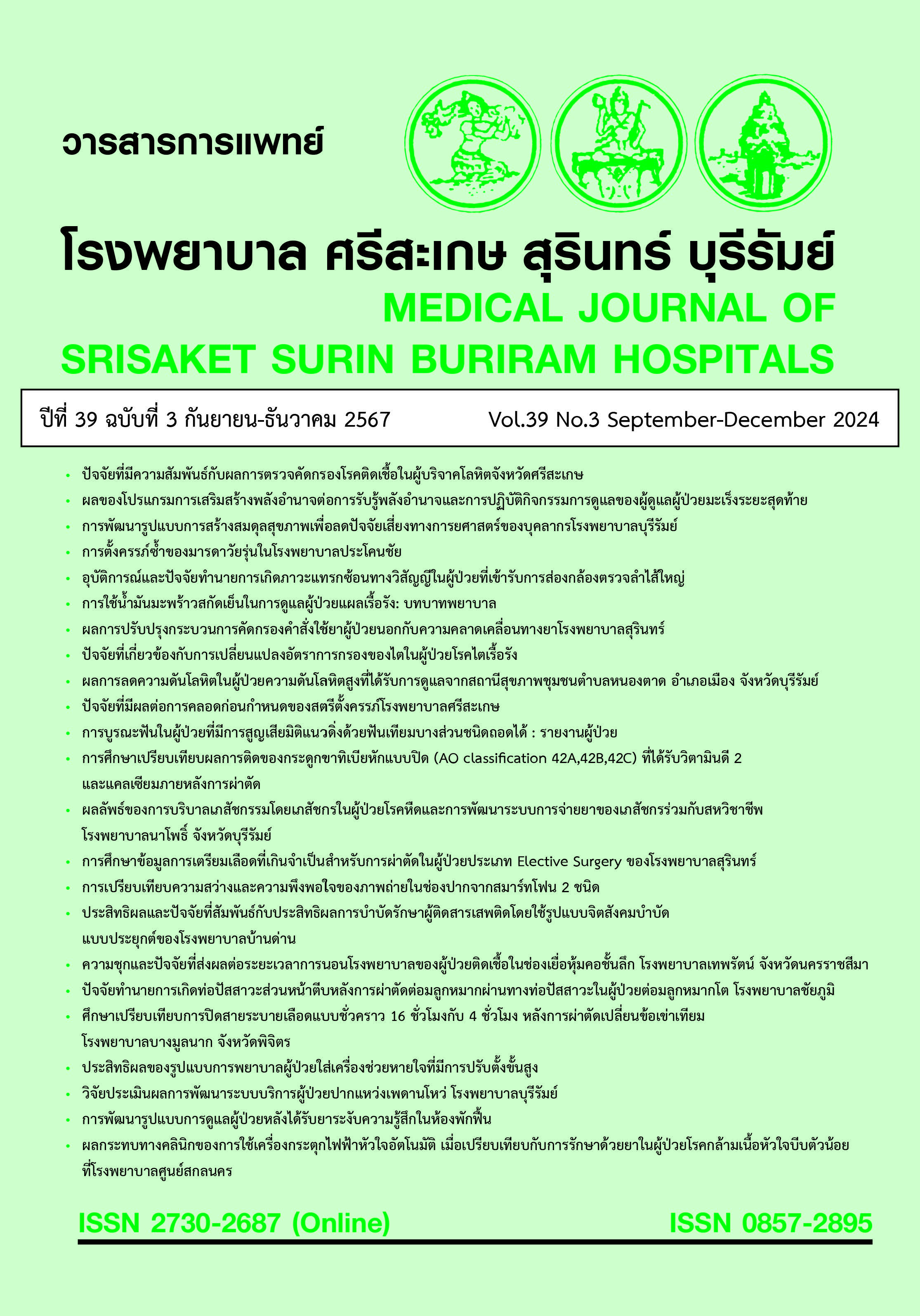ปัจจัยที่เกี่ยวข้องกับการเปลี่ยนแปลงอัตราการกรองของไตในผู้ป่วยโรคไตเรื้อรัง
Main Article Content
บทคัดย่อ
หลักการและเหตุผล: โรคไตเรื้อรัง เป็นภาวะที่พบได้บ่อย และมีผลกระทบต่อคุณภาพชีวิตของผู้ป่วย โดยเฉพาะในระยะที่ 3 และ 4 การควบคุมปัจจัยเสี่ยงต่างๆ เช่น ความดันโลหิต Urine Albumin และค่าความเข้มข้นเลือด มีความสำคัญในการชะลอการเปลี่ยนแปลงอัตราการกรองของไต การระบุปัจจัยที่ส่งผลต่อการเปลี่ยนแปลงอัตราการกรองของไต ในระยะนี้เป็นสิ่งสำคัญในการพัฒนาวิธีการดูแล และรักษาผู้ป่วยโรคไตเรื้อรัง
วัตถุประสงค์: เพื่อศึกษาปัจจัยที่เกี่ยวข้องกับการเปลี่ยนแปลงอัตราการกรองของไต ของผู้ป่วยโรคไตเรื้อรังในพื้นที่อำเภอสังขะ จังหวัดสุรินทร์ ปี ปีงบประมาณ 2566
วิธีการศึกษา: การศึกษาย้อนหลังแบบกลุ่ม (Retrospective Cohort Study) ครั้งนี้ใช้ข้อมูลผู้ป่วยไตวายเรื้อรังระยะที่ 3 และ 4 จำนวน 268 ราย ที่เข้ารับการรักษาที่โรงพยาบาลสังขะ จังหวัดสุรินทร์ ตั้งแต่วันที่ 1 ตุลาคม พ.ศ. 2565 ถึง 30 กันยายน พ.ศ. 2566 ข้อมูลที่เก็บรวบรวมได้รวมถึงอายุ เพศ ระยะเวลาที่มีโรคเบาหวาน ความดันโลหิต Systolic และ Diastolic ประวัติการรับยา ระดับ HbA1c Hematocrit BMI และผลการตรวจปัสสาวะ การวิเคราะห์ใช้สถิติ Univariate และ Multivariate Linear Regression เพื่อประเมินความสัมพันธ์ระหว่างปัจจัยต่างๆ กับเปลี่ยนแปลงอัตราการกรองของไต
ผลการศึกษา: จากการคำนวณ Univariate Analysis พบว่าความดันโลหิต Systolic, Urine Albumin และ Hct มีความสัมพันธ์อย่างมีนัยสำคัญกับการเปลี่ยนแปลงอัตราการกรองของไต โดย ค่าความดันโลหิต Systolic BP (Coefficient = 0.1, p-value = 0.019) และค่า Urine Alb (Coefficient = 1.3, p-value = 0.000) มีความสัมพันธ์เชิงบวกกับการเปลี่ยนแปลงค่าอัตราการกรองของไต และ Hct (Coefficient = -0.2, p-value = 0.020) มีความสัมพันธ์เชิงลบกับการเปลี่ยนแปลงค่าอัตราการกรองของไต ในผู้ป่วยไตเรื้อรัง อย่างมีนัยสำคัญทางสถิติ
สรุป: การควบคุมความดันโลหิต การตรวจสอบ Urine Albumin และการจัดการภาวะโลหิตจางเป็นสิ่งสำคัญในการชะลอการเปลี่ยนแปลงอัตราการกรองของไต ในผู้ป่วยโรคไตเรื้อรัง
Article Details

อนุญาตภายใต้เงื่อนไข Creative Commons Attribution-NonCommercial-NoDerivatives 4.0 International License.
เอกสารอ้างอิง
Levey AS, Eckardt KU, Tsukamoto Y, Levin A, Coresh J, Rossert J, et al. Definition and classification of chronic kidney disease: a position statement from Kidney Disease: Improving Global Outcomes (KDIGO). Kidney Int 2005;67(6):2089-100. doi: 10.1111/j.1523-1755.2005.00365.x.
Ingsathit A, Thakkinstian A, Chaiprasert A, Sangthawan P, Gojaseni P, Kiattisunthorn K, et al. Prevalence and risk factors of chronic kidney disease in the Thai adult population: Thai SEEK study. Nephrol Dial Transplant 2010;25(5):1567-75. doi: 10.1093/ndt/gfp669.
Kanjanabuch T, Takkavatakarn K. Global Dialysis Perspective: Thailand. Kidney 360 2020;1(7):671-5. doi: 10.34067/KID.0000762020.
Jongudomsuk P, Srithamrongsawat S, Patcharanarumol W, Limwattananon S, Pannarunothai S, Vapatanavong P, et al. The Kingdom of Thailand Health System Review. Health Syst Transit 2015;5(5):1-326.
Schiffrin EL, Lipman ML, Mann JF. Chronic kidney disease: effects on the cardiovascular system. Circulation 2007;116(1):85-97. doi: 10.1161/CIRCULATIONAHA.106.678342.
Fine LG, Norman JT. Chronic hypoxia as a mechanism of progression of chronic kidney diseases: from hypothesis to novel therapeutics. Kidney Int 2008;74(7):867-72. doi: 10.1038/ki.2008.350.
Lewis EJ, Hunsicker LG, Clarke WR, Berl T, Pohl MA, Lewis JB, et al. Renoprotective effect of the angiotensin-receptor antagonist irbesartan in patients with nephropathy due to type 2 diabetes. N Engl J Med 2001;345(12):851-60. doi: 10.1056/NEJMoa011303.
Kostourou DT, Milonas D, Polychronopoulos G, Sofogianni A, Tziomalos K. The Role of Angiotensin Receptor Blockers in the Personalized Management of Diabetic Neuropathy. J Pers Med 2022;12(8):1253. doi: 10.3390/jpm12081253.
Green SB. How Many Subjects Does It Take To Do A Regression Analysis. Multivariate Behav Res 1991;26(3):499-510. doi: 10.1207/s15327906mbr2603_7.
Whelton PK, Carey RM, Aronow WS, Casey DE Jr, Collins KJ, Dennison Himmelfarb C, et al. 2017 ACC/AHA/AAPA/ABC/ACPM/AGS/APhA/ASH/ASPC/NMA/PCNA Guideline for the Prevention, Detection, Evaluation, and Management of High Blood Pressure in Adults: Executive Summary: A Report of the American College of Cardiology/American Heart Association Task Force on Clinical Practice Guidelines. Hypertension 2018;71(6):1269-1324. doi: 10.1161/HYP.0000000000000066.
Kidney Disease: Improving Global Outcomes (KDIGO) Diabetes Work Group. KDIGO 2020 Clinical Practice Guideline for Diabetes Management in Chronic Kidney Disease. Kidney Int 2020;98(4S):S1-S115. doi: 10.1016/j.kint.2020.06.019.
Heerspink HJ, Ninomiya T, Persson F, Brenner BM, Brunel P, Chaturvedi N, et al. Is a reduction in albuminuria associated with renal and cardiovascular protection? A post hoc analysis of the ALTITUDE trial. Diabetes Obes Metab 2016;18(2):169-77. doi: 10.1111/dom.12600.
Matsushita K, van der Velde M, Astor BC, Woodward M, Levey AS, de Jong PE, et al. Association of estimated glomerular filtration rate and albuminuria with all-cause and cardiovascular mortality in general population cohorts: a collaborative meta-analysis. Lancet 2010;375(9731):2073-81. doi: 10.1016/S0140-6736(10)60674-5.
Levey AS, Coresh J, Balk E, Kausz AT, Levin A, Steffes MW, et al. National Kidney Foundation practice guidelines for chronic kidney disease: evaluation, classification, and stratification. Ann Intern Med 2003;139(2):137-47. doi: 10.7326/0003-4819-139-2-200307150-00013.
Gansevoort RT, Matsushita K, van der Velde M, Astor BC, Woodward M, Levey AS, et al. Lower estimated GFR and higher albuminuria are associated with adverse kidney outcomes. A collaborative meta-analysis of general and high-risk population cohorts. Kidney Int 2011;80(1):93-104. doi: 10.1038/ki.2010.531.
Fishbane S, Pollack S, Feldman HI, Joffe MM. Iron indices in chronic kidney disease in the National Health and Nutritional Examination Survey 1988-2004. Clin J Am Soc Nephrol 2009;4(1):57-61. doi: 10.2215/CJN.01670408.
Thomas MC, Tsalamandris C, MacIsaac RJ, Jerums G. The epidemiology of hemoglobin levels in patients with type 2 diabetes. Am J Kidney Dis 2006;48(4):537-45. doi: 10.1053/j.ajkd.2006.06.011.
Brownlee M. The pathobiology of diabetic complications: a unifying mechanism. Diabetes 2005;54(6):1615-25. doi: 10.2337/diabetes.54.6.1615.
Kalantar-Zadeh K, Kramer HM, Fouque D. High-protein diet is bad for kidney health: unleashing the taboo. Nephrol Dial Transplant 2020;35(1):1-4. doi: 10.1093/ndt/gfz216.
Bakris GL, Agarwal R, Anker SD, Pitt B, Ruilope LM, Rossing P, et al. Effect of Finerenone on Chronic Kidney Disease Outcomes in Type 2 Diabetes. N Engl J Med 2020;383(23):2219-29. doi: 10.1056/NEJMoa2025845.


